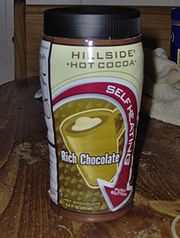
Self-heating can
Encyclopedia

Tin can
A tin can, tin , steel can, or a can, is a sealed container for the distribution or storage of goods, composed of thin metal. Many cans require opening by cutting the "end" open; others have removable covers. Cans hold diverse contents: foods, beverages, oil, chemicals, etc."Tin" cans are made...
. Self-heating cans have dual chambers, one surrounding the other. The inner chamber holds the food or drink, and the outer chamber houses chemicals that undergo an exothermic reaction
Exothermic reaction
An exothermic reaction is a chemical reaction that releases energy in the form of light or heat. It is the opposite of an endothermic reaction. Expressed in a chemical equation:-Overview:...
when combined. When the user wants to heat the contents of the can, they pull a ring on the can that breaks the barrier separating the chemicals in the outer chamber. After the heat from the reaction has been absorbed by the food, the user can enjoy a hot meal or drink.
Current versions of the self-heating can work in much the same way, but have the chemicals in the inner chamber and the beverage surrounding it in the outer chamber. This design has the advantages of being more efficient (less heat is lost to the surrounding air) as well as reducing excessive heating of the product's exterior, causing possible discomfort to the user.
Self-heating cans offer benefits to campers and people without access to a microwave oven, stove or camp-fire, but the technology is not yet common. This is because self-heating cans are considerably more expensive than the conventional type, and also have problems with uneven heating of their contents.
Technology
The source of the heat for the self-heated can is an exothermic reactionExothermic reaction
An exothermic reaction is a chemical reaction that releases energy in the form of light or heat. It is the opposite of an endothermic reaction. Expressed in a chemical equation:-Overview:...
that the user initiates by pressing on the bottom of the can. The can is manufactured as three containers. A container for the beverage surrounds a container of the heating agent separated from a container of water by a thin breakable membrane. When the user pushes on the bottom of the can, a rod pierces the membrane, allowing the water and heating agent to mix. The resulting reaction releases heat thus warms the beverage surrounding it.
The heating agent and responsible reaction vary from product to product. Calcium oxide is used in the following reaction:
- CaO(s)+ H2O(l) → Ca(OH)2(s)
Copper sulfate and powdered zinc
Zinc
Zinc , or spelter , is a metallic chemical element; it has the symbol Zn and atomic number 30. It is the first element in group 12 of the periodic table. Zinc is, in some respects, chemically similar to magnesium, because its ion is of similar size and its only common oxidation state is +2...
can also be used, but to lesser effect:
- CuSO4(s) + Zn(s) → ZnSO4(s) + Cu(s)
Anhydrous calcium chloride
Calcium chloride
Calcium chloride, CaCl2, is a salt of calcium and chlorine. It behaves as a typical ionic halide, and is solid at room temperature. Common applications include brine for refrigeration plants, ice and dust control on roads, and desiccation...
is often used as well. In this case, no chemical reaction occurs, instead the heat of solution
Enthalpy change of solution
The enthalpy of solution, enthalpy of dissolution, or heat of solution is the enthalpy change associated with the dissolution of a substance in a solvent at constant pressure resulting in infinite dilution....
is generated.
External links
- Fast Drinks 2GO Self Heating Drinks
- An article on the concept
- Single-serving coffee can heats itself
- Will Self-Heating Coffee Be Cool?
- The world's first self-heating coffee with demonstration pictures
- Dawn of the New Can
- BBC News OnlineBBC News OnlineBBC News Online is the website of BBC News, the division of the BBC responsible for newsgathering and production. The website is the most popular news website in the United Kingdom and forms a major part of BBC Online ....
- Hot drink can tested in Midlands - An article with photos on disassembly

